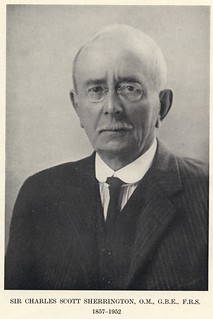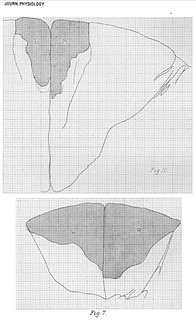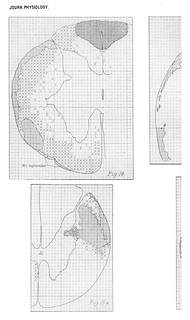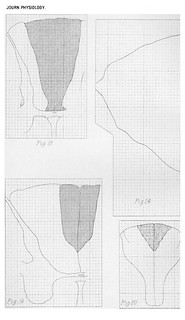- Creation
-
Creators (Definite): Sir Charles Scott Sherrington; The Cambridge Engraving CompanyDate: 1893
- Current Holder(s)
-
- No links match your filters. Clear Filters
-
Cited by
 C.S. Sherrington, 'Note on the Spinal portion of some Ascending Degenerations', Journal of Physiology 14 (4-5) (1893), pp. 255-302.
C.S. Sherrington, 'Note on the Spinal portion of some Ascending Degenerations', Journal of Physiology 14 (4-5) (1893), pp. 255-302.
Description:Fig. 23 in text:
'Weigert-Pal preparations. At the level of the 2nd thoracic root 49 squares were counted in the median posterior column of the right side and 323 in the column of the left side. The 49 squares contained 2317 nerve-fibres, the 323 squares 14891 nerve-fibres; the 49 right hand squares gave an average therefore of 47.2 nerve-fibres per square, the 323 an average of 46.1 per square. (Fig. 23.)
At the level of the 2nd cervical root 49 squares in approximately the same part of the column as the 49 taken at the 2nd thoracic root contained 2394 nerve-fibres, i.e. 488 fibres per square. In the other column, i.e. right hand, 196 squares were counted in a position more closely abutting upon the dorsal angle of the column and more closely hugging the median dorsal septum than the squares counted at the 2nd thoracic level, in order to allow for the kind of shifting of position to which the fibres in the column are subjected as revealed by the degenerations studied above. (Fig. 24.) In the 196 squares 9724 fibres were found, giving an average of 49.6 to the square. The condensation found therefore would account for a diminution in size of the area of absolute degeneration of about 8 p.c.' (288)
Figs. 25-26 in text:
'An obvious objection to this interpretation of the occurrence of "geminal fibres " is that where numerous degenerate fibres are present it is only in accordance with probability that in some cases two will happen to lie alongside each other. Against the appearance being thus explicable as a mere chance juxtaposition, it has to be remembered that the fibres referred to are not merely juxtaposed, but are also as judged of by the tint that they assume under various staining methods, and by the degree of formal disintegration which they exhibit, in the same stage of decay one as another (Fig. 25); and further that in some instances they exhibit the possession of a sheath common to both of the two fibres (Fig. 26).' (295)
Fig. 26 in text:
'Although the fibres of the pyramidal tract are in the cord largely commingled with other fibres, in the pyramid itself its fibres are not commingled with others except with arciform, easily distinguishable by their course in a plane at right angles to that of the pyramidal fibres. At the same time not quite all the fibres of one pyramid degenerate after even very large ablations from the cortex of one hemisphere. I attempted therefore to obtain a very large and complete degeneration of the pyramid and to then see if the few sound fibres remaining in the degeneration mass occurred in pairs; in fact one attempted to obtain a positive picture of the fibres in place of the negative already furnished. Search made in this way reveals both in Rhesus (Fig. 26) and in Dog numerous examples of "geminal" arrangement among the sparse sound fibres in a severely degenerated pyramid, in fact most of the larger of the sound fibres occur in pairs, a few in triplets.' (295-296)
Fig. 30 in text:
' it might be expected that "geminal" fibres just as they degenerate together and escape degeneration together, might together myelinate. This is in fact the case. Fibres myelinating in pairs are numerous in the developing cord. Fig. 30 represents an instance from the human cord. The pairs both small and large are numerous in the developing cord, and especially so the larger.' (297)












